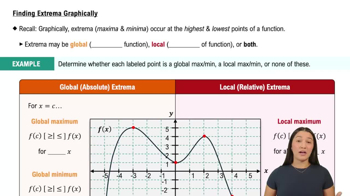Table of contents
- 0. Functions7h 52m
- Introduction to Functions16m
- Piecewise Functions10m
- Properties of Functions9m
- Common Functions1h 8m
- Transformations5m
- Combining Functions27m
- Exponent rules32m
- Exponential Functions28m
- Logarithmic Functions24m
- Properties of Logarithms34m
- Exponential & Logarithmic Equations35m
- Introduction to Trigonometric Functions38m
- Graphs of Trigonometric Functions44m
- Trigonometric Identities47m
- Inverse Trigonometric Functions48m
- 1. Limits and Continuity2h 2m
- 2. Intro to Derivatives1h 33m
- 3. Techniques of Differentiation3h 18m
- 4. Applications of Derivatives2h 38m
- 5. Graphical Applications of Derivatives6h 2m
- 6. Derivatives of Inverse, Exponential, & Logarithmic Functions2h 37m
- 7. Antiderivatives & Indefinite Integrals1h 26m
- 8. Definite Integrals4h 44m
- 9. Graphical Applications of Integrals2h 27m
- 10. Physics Applications of Integrals 2h 22m
5. Graphical Applications of Derivatives
Intro to Extrema
Problem 4.3.62
Textbook Question
Sketching curves Sketch a graph of a function f that is continuous on (-∞,∞) and has the following properties.
f'(x) < 0 and f"(x) > 0 on (-∞,0); f'(x) > 0 and f"(x) < 0 on (0,∞)
 Verified step by step guidance
Verified step by step guidance1
Start by understanding the properties of the function f. The function is continuous on (-∞, ∞), meaning there are no breaks, jumps, or holes in the graph.
Analyze the interval (-∞, 0). Here, f'(x) < 0 indicates that the function is decreasing, and f''(x) > 0 suggests that the function is concave up. This means the graph is sloping downwards but curving upwards, resembling a downward-sloping curve that is opening upwards.
Next, consider the interval (0, ∞). In this region, f'(x) > 0 implies the function is increasing, and f''(x) < 0 indicates that the function is concave down. This means the graph is sloping upwards but curving downwards, resembling an upward-sloping curve that is opening downwards.
Identify the behavior at x = 0. Since the function transitions from decreasing and concave up to increasing and concave down, x = 0 is likely a point of inflection where the concavity changes.
Combine these observations to sketch the graph. Start with a curve that decreases and is concave up on (-∞, 0), then smoothly transition at x = 0 to a curve that increases and is concave down on (0, ∞). Ensure the graph is continuous and reflects the described properties.
 Verified video answer for a similar problem:
Verified video answer for a similar problem:This video solution was recommended by our tutors as helpful for the problem above
Video duration:
3mPlay a video:
Was this helpful?
Key Concepts
Here are the essential concepts you must grasp in order to answer the question correctly.
Derivative and Its Significance
The derivative of a function, denoted as f'(x), represents the rate of change of the function at a given point. If f'(x) < 0, the function is decreasing, while f'(x) > 0 indicates that the function is increasing. Understanding the sign of the derivative is crucial for determining the behavior of the function across different intervals.
Recommended video:

Derivatives
Second Derivative and Concavity
The second derivative, f''(x), provides information about the concavity of the function. If f''(x) > 0, the function is concave up, suggesting that the slope of the function is increasing. Conversely, if f''(x) < 0, the function is concave down, indicating that the slope is decreasing. This concept is essential for sketching the graph accurately.
Recommended video:

The Second Derivative Test: Finding Local Extrema
Continuity of Functions
A function is continuous on an interval if there are no breaks, jumps, or holes in its graph. For the function f to be continuous on (-∞, ∞), it must be defined for all x in that interval and must not have any discontinuities. This property ensures that the function can be graphed smoothly, which is vital for visualizing its behavior based on the given derivative conditions.
Recommended video:

Intro to Continuity

 5:58m
5:58mWatch next
Master Finding Extrema Graphically with a bite sized video explanation from Callie
Start learning





